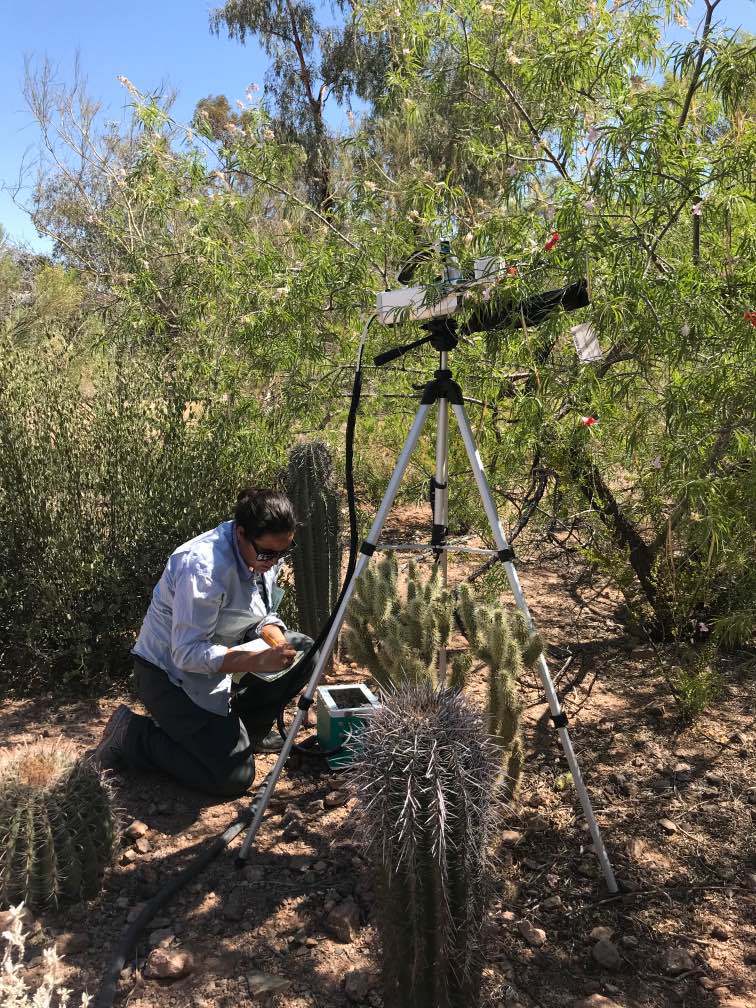Lab postdoc Luiza Aparecido just had a paper published in Ecology Letters showing that leaf water and carbon use in Sonoran Desert plants challenges current stomatal regulation theory – many species use far more water than expected in hot conditions, even when carbon gain is not occurring. This is her guest post. You can https://onlinelibrary.wiley.com/doi/abs/10.1111/ele.13516 or download a PDF.
Almost exactly two years after we sent out the decision letters to our first batch of undergraduate summer interns, we are pleased to share that our paper “High water use in desert plants exposed to extreme heat” has been published online in the journal Ecology Letters. As a “pilot” study to a future field campaign in the tropics, we were not aware of how much we would learn from a set of 11 Sonoran desert plant species chosen nearly at random at/close to the trails of the Desert Botanical Garden (DBG) during the summer/2018.
Our main finding was that desert plants that have more carbon expensive leaves (i.e., evergreen plants with high leaf mass) willingly or unknowingly preserve their leaf tissues through an excessive amount of water loss that ultimately cools the leaves and prevents lethal heat damage. In addition to losing expensive desert water to cool down their leaves, the high leaf temperatures measured (as high as 50 °C/122 °F) compromised carbon assimilation possibly due to high temperatures, making these plants very little water use efficient. Although these species (called “alternative water users” – 36% of the species studied) did not necessarily become cooler than air, we believe that they cooled themselves enough to preserve photosynthetic tissue that will be used the next day (especially in the cooler mornings), instead of losing the leaf permanently and the potential to assimilate carbon until a new one is developed. Considering how slow growing desert plants are, the regrowth of new leaves during the hot summers would probably only occur after monsoon storms occur (August-September, thus 2-3 months later). The plants sampled most likely accessed a larger amount of water than plants occurring in their native habitat, thus the prevalence of this alternative water use in natural systems remains unknown (for now). Ultimately, we believe that this alternative water use are or will be become more prevalent as heatwaves and drought events also become more frequent as climate change progresses.
This paper was led by myself (Dr. Luiza Aparecido) and closely advised by Dr. Benjamin Blonder and Dr. Kevin Hultine (Desert Botanical Garden). More specifically, this study would not have come to fruition if it wasn’t for the hard work and inquisitive nature of two undergraduate students (Sabrina Woo and Crystal Suazo – see previous post “Coping with the heat – celebrating undergraduate research”), who co-author this paper. The gas exchange data for this study was collected during only 3 weeks in June/2018, myself and the students were at DBG from 4:30AM until 10PM every day. Those days consisted of many middays under a tiny umbrella; many cacti thorn-poking; great facial tans; frustration towards brittlebush leaf “brittleness” (SO MANY measurements had to be re-done!); probably a couple of miles hauling a car battery for the thermal camera usage; and answering many curious questions from DBG visitors. But mostly, this project was filled with a lot of science-sharing, mentorship skill development, undergraduate research excelling (Sabrina Woo won two awards through ASU SOLS; Crystal Suazo was offered a longer-term internship at a prestigious lab at ASU), and many cheerful conversations (albeit) under the sun. I appreciate the patience and trust the students and my advisers had on me! Hopefully more desert work will come out soon as a follow up from this one and will help substantiate our findings, and move a step closer to improving current stomatal regulation models for aridland plants.








